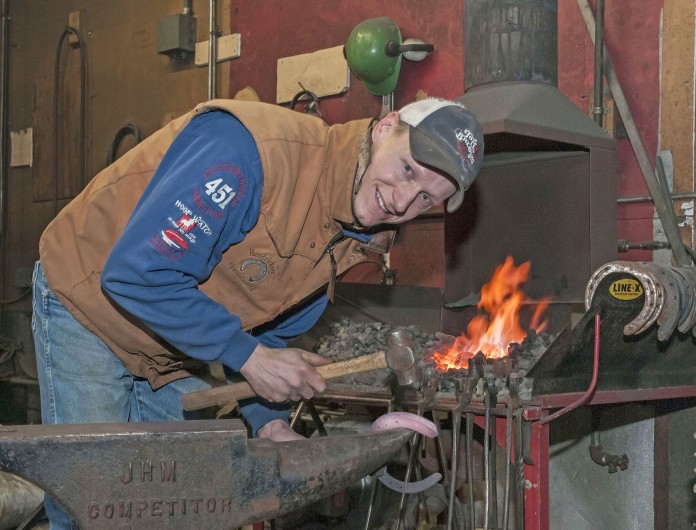Stephen Hendrickson is a farrier in Isanti, Minn.
Stephen Hendrickson worked full-time for the Minnesota Department of Natural Resources, but “I always wanted to do something with horses,” he said. “I watched a farrier do one foot on one horse and decided I wanted to do that.” In 2001, he took the 10-week course through the Minnesota School of Horseshoeing and started his new career part-time.
“I hated it for the first year,” he said. “I decided I wouldn’t quit until I had the skill level to see whether I could do it or not.”
He moved to the Twin Cities area to apprentice full-time with an experienced farrier. “I never moved back,” he said – although “it was probably two years before I enjoyed the job.”
Hendrickson said people use “farrier” and “horse shoer” interchangeably, “but we don’t just shoe. We trim their feet. A horse’s feet are usually due for a trim every four to six weeks. A lot don’t wear shoes, so we just trim the excess foot off so the horse can perform better. Most horses that are performing at a high level do wear shoes.”
Care of the feet is the second most important thing to the health of the horse, aside from feeding, Hendrickson said. Trimming is the typical entry-level task for a farrier. “As you go on, you do more shoeing and less trimming,” he said. “The majority of farriers use store-bought shoes. They are called ‘keg shoes’ because they used to be shipped in kegs. Then you shape them to fit a foot and nail them on. In school and in the World Championship competitions, everything is done with handmade shoes because it shows a higher skill level. With a handmade shoe, you can punch your nails wherever they need to be for that particular foot.” Hendrickson now hand-forges about 50 percent of the shoes he uses.
Hendrickson said there are both full-time and part-time farriers. “It depends on how hard you work and your skill level,” he said. To build his skill, Hendrickson took the 10-week course, then apprenticed for free for three years as he built his own business. He earned a journeyman certification from the American Farriers Association and in recent years has entered World Championship Blacksmiths competitions.
“You’re either going to get tired of it or you get more and more addicted to it,” he said. “That’s what happened to me.”
Why does a horse need a farrier’s services?
Balance is the big thing – you’re making it so that horse is the most comfortable to perform its job. A horse’s feet grow out of balance. We make the horse as strong as it can be. You don’t just look at the foot. You look at the whole body. That will determine how you work on each particular foot.
What part of the job is the most fun?
I love making horse shoes. That’s my favorite part. But I also enjoy having good clients I see on a regular basis. You get to know them very well.
Is horsemanship a prerequisite for horseshoeing?
Horsemanship skills are very important, but not required. When I have an apprentice with horse experience I can trust them to work with less supervision. You want to train your clients to handle their horses – then it’s not as much of an issue. You still have to be able to read an animal and what it’s going to do.
Photo Credit: Tom Witta
Link: http://www.startribune.com/my-job-stephen-hendrickson-farrier/293671051/











